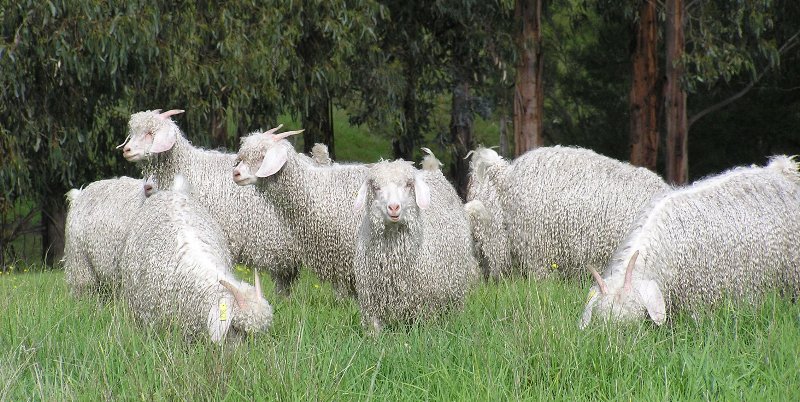
RARE BREEDS TRUST OF AUSTRALIA
powered by TidyHQGoats: Australian Heritage Angora
Goats: Australian Heritage Angora
 Status
Status

Breed traits
The breed is thrifty, hardy and has clean legs and an open face that doesn't need to be wigged to enable clear vision. They have quiet temperaments, are easy animals to look after and are ideally suited to Australian conditions.
Their fleece is beautiful for hand spinning, being easy to prepare as no harsh chemicals are needed to clean it. It's softness, silkiness and lustre are its redeeming qualities. Yields remain about the same as they were in the 1800's, around 1.5kg per doe, significantly less than the 3kg shorn from a modern day, improved Angora.
Photo of a group of Angora does at Croajingolong Stud, courtesy of Valerie Donald.
History in Australia
Angora goats were first imported into Australia in 1832 and 1833 by Alexander Riley, of Raby, NSW, from M. Polonceau's flock in France. Purebred Angoras from the herd of the Duchess of Berri were imported in 1833.
M. Polonceau of France started crossbreeding Angora goats and Cashmeres in 1822 and the type was fixed in 1827. Purebred Angoras were imported from Turkey, the home of the Angora goat, in 1853, 1856,1863, 1865, 1869, 1871, and 1873. There was every possibility that some were upgraded Angoras originating from the "Turkish Native" or "Anatolian Black", a fleece and meat goat, as Turkey had begun an upgrading program to rapidly increase numbers. By 1870 the original Angora in Turkey was virtually extinct.
In 1856, seven pure bred Angora goats were imported from Turkey by Mr Sichel and these went to the Acclimatisation Society of Victoria, in Royal Park, Melbourne. In 1863 twelve bucks arrived at Royal Park from France, presumably the M. Polonceau type. In 1865 a further ninety-eight Angoras were imported from Turkey and joined the Royal Park flock. By 1870, the Royal Park flock, which had greatly increased was dispersed. Mr Wilson, who was associated with Royal Park took fifty of the best to his Wimmera property and the remainder was sold to various purchasers.
South African blood was introduced into Trawalla, Victoria in 1873 although the type and number is not known. John Giles of Bairnsdale owned a flock in the latter part of the 19th century and the "Banksia" stud, which was started in 1904, was based on Giles and Peak Station blood, which in turn was based on Kempe's flock started in 1888 from Price Muriel's flock. Price Muriel imported one hundred and eighty-four Angoras from Turkey between 1869 and 1873. Muriel sold his flock around 1890 and Mr E.C. Kempe bought one hundred and forty-four to add to his flock. In 1901 Kempe, in partnership with Sir Sydney Kidman, bought Peak Station and in 1902 there were one thousand Angoras on Peak Station. The number grew to over two thousand and they were said to be of very good quality. The flock was dispersed at the time of Kempe's death in 1906 and some of the flock was purchased by "Banksia".
During the 1920's and 1930's there was virtually no interest in Angoras in Australia and by 1950, all interest had gone, with the only flock with a history going back to "the good old days" was "Banksia". For all practical purposes the flocks built up in the 19th and very early 20th centuries had been killed of or allowed to go feral.
The Banksia stud of Mr Barton was registered with the Goat Breed Society of Australia in 1947. By 1963 fourteen studs were registered with this Society. Volumes 5 to 16 of the Goat Breed Society of Australia records the first five hundred that were pure bred. Later volumes include animals that cannot be traced directly and solely to the Banksia purebred flock. With the upsurge of interest in the Angora goat, an upgrading program began in the 1960's using feral and dairy goats.
All Australian Heritage Angora goats trace their pedigrees back to the purebred Banksia flock. There are only three registered studs breeding the Australian Heritage Angora goat.
Records of the breeding of the Australian Heritage Angora goat have been kept since 1950 and annual published records since 1973. The Australian Mohair industry boomed in the late 1970's based on these Banksia derived animals. Buyers from the UK encouraged production and animals were sought and exported to the UK and New Zealand. Higher yielding lines were introduced from oversaes in the 1980's. Since then South African and Texan Angoras have taken over, to the detriment of the Australian Heritage Angora.
Today, around 50 Australian Heritage Angoras remain as a symbol of Australia's quality heritage beginnings.
Breed association
For further information on Heritage Angoras contact the Heritage Angora Society of Australia.
Credits
All information for this article was supplied by Valerie Donald, Croajingalong Heritage Angora Goats.
